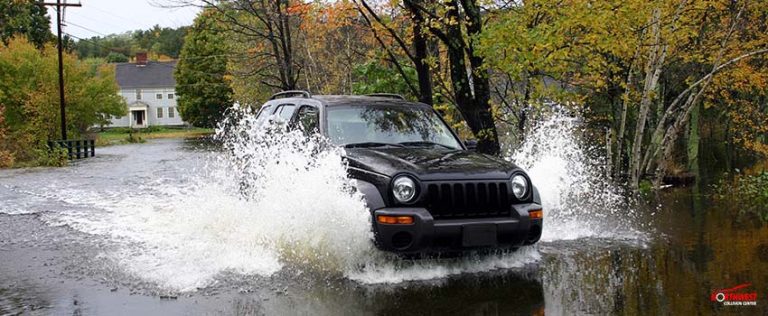Drivers should be extra cautious during heavy rains or tropical storms. This is because when there’s too much water on the street, flooded roadways and water-related hazards will not be far behind.
According to the National Weather Service, the majority of flood-related drownings were due to car owners driving their automobiles into dangerous water. The recommendation is to simply turn your car around if you encounter standing water on the road six inches deep or more. This is especially true if you’re driving at night when the dangers of floodwater is more difficult to determine.
Dangers of Driving Through Flooded Roads
Heavy rains can make driving difficult. This is due to slippery roads and reduced visibility as well as the danger of encountering flooded streets.
If you’re still unaware, driving on flooded roads is dangerous because of the following:
1. You’re not sure what lies under the water.
Under the calm water surface, there could be severely damaged pavement, manhole covers, out-of-place drains, deep potholes, and worse, a huge sinkhole waiting to swallow up your car. The latter is possible because when there’s too much moving water on the road, it is likely that the gravel, dirt, and rocks that support the pavement have been washed away. Thus, what appears to be a dry and secure area could actually be a deep pit waiting for your car to move in and fall down.
2. You and your car could get swept away by the water.
Flood water is dangerous, especially if it is moving. If the current is strong enough, most cars can easily be swept away. Per the NWS, water one foot deep can move small cars, while two feet of raging waters can dislodge most vehicles and transport them elsewhere. Off-roaders should not think they are immune from the risks involved when driving on flooded roads. A heavy 4×4 can be dislodged if the water level is increased by at least one foot.
3. Floodwater can hydro-lock your car engine.
To aid in the combustion process, your engine must be continually refilled with fresh air. However, if there’s water all around, it will likely get inside the engine and cause significant damage. An engine flooded with water is never a good thing because this will mean expensive repairs, or worse, a complete engine replacement.
Although modern engines can pull water up to 19 feet long, if this is standing near the intake, or splashing into it, water will somehow get in. Engine hydro-locking can result, even with just a few hundred milliliters of water.
4. You could underestimate the water’s depth.
This is always a possibility because flooded roadways can be deceiving. What appears to be shallow may actually be large enough to sink you and your car. Getting out can prove to be difficult once you’re submerged in murky waters. The surrounding pressure will make it impossible to open the car door. Slowly, water will enter your car and trap you inside.
5. Floodwater could contaminate car fluids.
Another risk about driving on flooded roads is that water can get into the compartment area and cause damage to vital fluids found in the transmission, engine, or brake. These fluids keep your car’s mechanical parts lubricated, free from debris, and help dissipate heat. They will not be able to perform these functions if water gets inside.
Contaminated fluids can cause excessive friction, heat, and abrasion. This can lead to premature wear of the car’s internal parts and could result in component failure.
6. Floodwater can cause corrosion.
Metal will rust when exposed to water. As your car is manufactured from metal, exposure to floodwater is practically an open invitation for corrosion to come in. If left untreated, you could end up facing more serious problems, so it’s best that you know what to do after driving through water.
7. Floodwater could damage car electronics.
Floodwater can cause severe damage to your car’s electrical wirings. Many modern cars also have computer systems that control basic functions like starting the engine. However, when water seeps through the system, it can lead to severe damage, including computer malfunction. Repairs can be both expensive and time-consuming, especially if your car’s electronic parts need to be replaced.
8. Floodwater can result in electrocution.
The path of least resistance is where electricity flows. This means that you are usually safe inside your car even while in floodwater. The problem begins when water gets in. Since water is a good conductor of electricity, there is a good chance of electrocution, especially if the water is deep, and your car inevitably sinks below.
9. The interior of your car can become smelly.
Flood water is usually filthy because it contains not only rainwater, but also sewage and other debris. This can seep into your vehicle and can cause mold and bacteria growth in your vehicle’s dark, poorly ventilated interior. This could lead to a bad smell and poor air quality and these will not likely go away until you do a thorough but expensive car cleanup.
10. Floodwater can leave your car soaked.
Even if the water doesn’t get into your engine, it will likely get inside the car. This is because your auto is not perfectly sealed and is designed that way. Air can flow in and out of the different spaces on your car, and many of these are located low to the ground.
Meanwhile, car carpets are usually made of large soft foam pads which absorb a lot of water. Although these are generally protected from damage by being placed under the seat and on the floor of your vehicle, carpets are still susceptible to water. Often, they help spread this inside your car until the flooring becomes soaked. If the water reaches the electrical systems, electrocution also becomes a distinct possibility.
Key Takeaway
Floodwater can cause damage, not only to the road, but also to your car. At best, you might get away with a few dents after driving through a flooded road, but in a worse case scenario, there will be car damage that you’ll have to deal with. These can include contaminated fluids, damaged electrical systems, corroded metal parts, and smelly interiors. Many of these will require a visit to a professional auto repair shop, which you can easily avoid if you just park your car somewhere safe until the water recedes instead of driving through the flood.
Contact Northwest Collision Center if you need help in repairing your flood-damaged car.
Car damage is often due to a road mishap, but sometimes, other external factors like driving on flooded roads can play a role in causing the ruin. Regardless of the cause, you can rely on Northwest Collision Center to deliver the expected repair outcome.
Our auto body shop in Largo, FL, is equipped with advanced repair technology and equipment and manned by highly-skilled technicians who will guarantee you excellent and satisfactory service. Call us now and see why we are the best when it comes to car repair and restoration.










